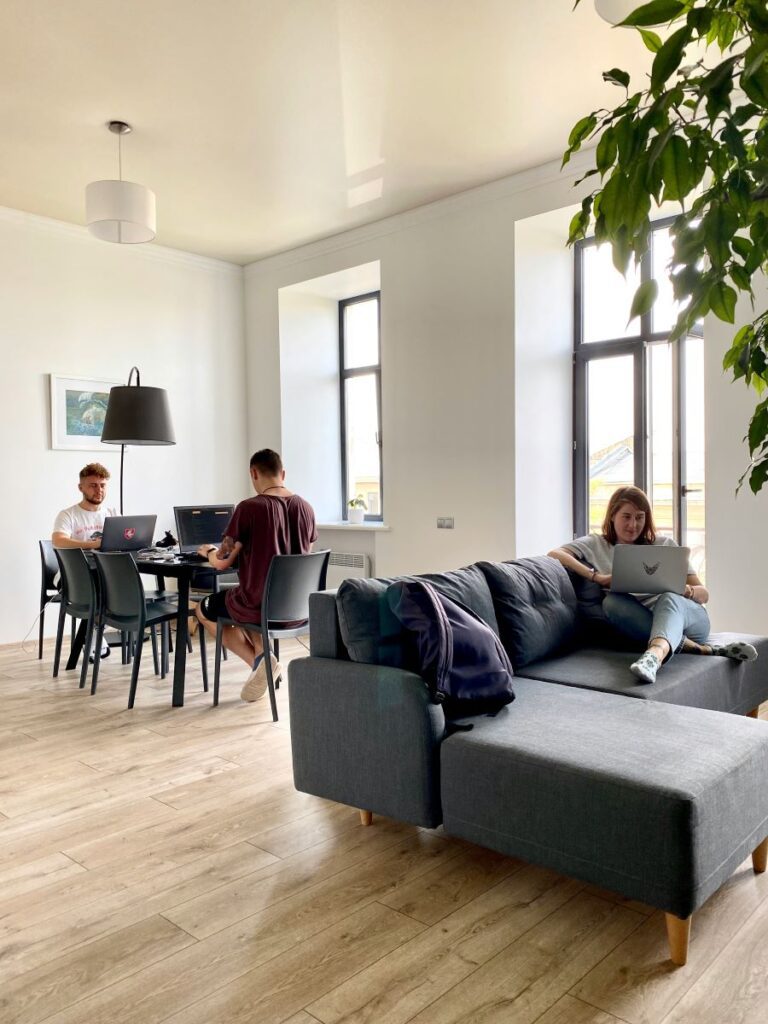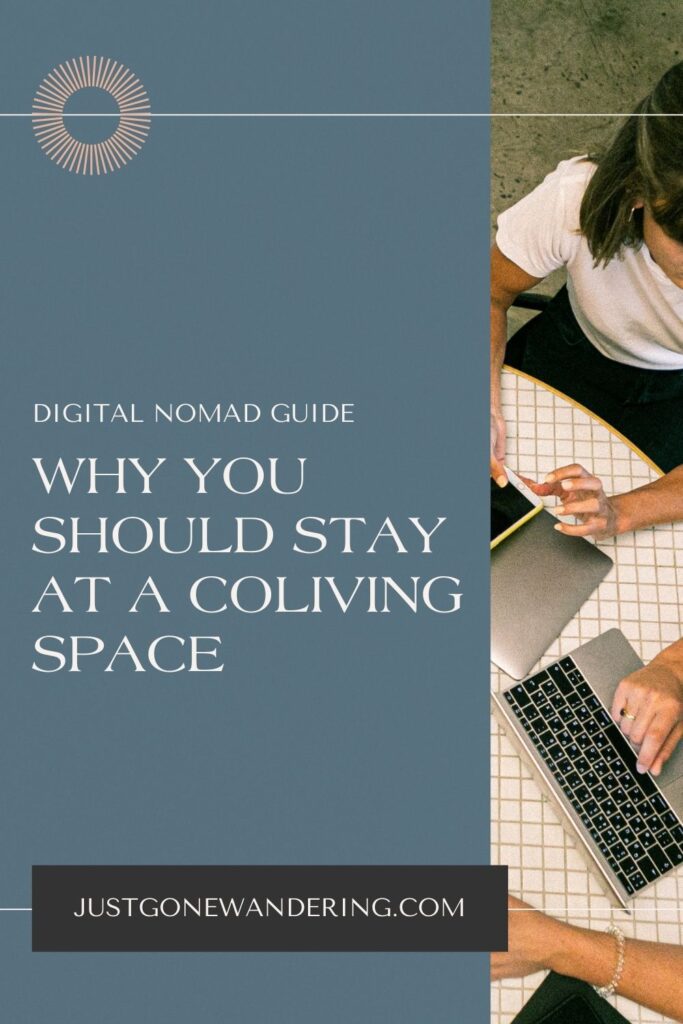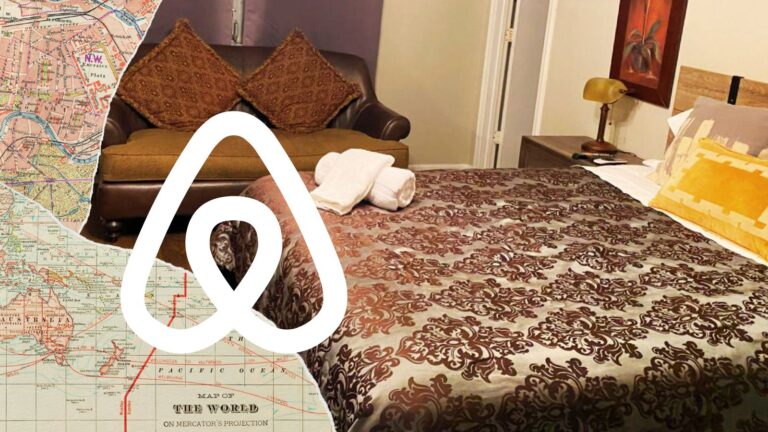What’s Coliving, Anyway? A Guide for Digital Nomads
I recently stayed in my first coliving space, and it got me thinking about utilizing shared spaces as a digital nomad.
Sharing a house with strangers might not sound like a dream at first, but for digital nomads, coliving is becoming the go-to way to live, work, and meet people on the road. It’s less chaotic than hostels, but not as isolating as solo apartments. It’s a great way to meet other people who love to travel, without the focus on cramming as much sightseeing as possible into a few short days.
If you’ve ever wondered what it’s like to live in a space designed for remote workers, you’re in the right place. This guide breaks down everything you need to know to decide if coliving is your next move.
Just Gone Wandering is supported by readers! This post contains affiliate links. If you click on a link and buy something, I get a small percentage at no extra cost to you. Your support helps keep this blog running— thank you! Read full disclosure here.
What is Coliving, Anyway?

Coliving is all about mixing community with convenience.
Picture a shared living space filled with open-minded folks, all juggling their own work routines but coexisting in a way that feels…seamless. It’s not just about sharing a roof: it’s about creating a vibe where people genuinely connect.
The heart of coliving lies in its emphasis on building community in spaces where you might normally be alone. Remote work can be very isolating, and coliving spaces are one way to combat that.
They’re built to cater to people with shared ambitions—freelancers, creatives, and digital nomads—looking for more than just a place to crash. It’s about merging personal spaces with communal ones, where the kitchen becomes a hub of random deep chats, and cozy lounges are perfect for binge-watching Netflix with housemates after a long workday.
What makes coliving special is how natural the collaboration and networking feel. Need advice? Someone in your coliving spot probably has answers or knows someone who does. I recently stayed in a coliving where I met programmers, bloggers, and copywriters! Even just being able to talk about our common issues with remote work was exciting.
On top of that, many coliving spaces host workshops, yoga sessions, or family dinners. It’s like a built-in community with a focus on balancing work and travel.
Does it occasionally feel like you’re perpetually stuck in social mode? Sure, especially after the fifth day of having hour-long conversations. If you’re super introverted, you may struggle. But the sense of connection you get often outweighs those moments of needing privacy.
Coliving vs. Hostels

At a glance, coliving spaces might seem a lot like hostels, but they cater to different needs.
Here’s what sets them apart:
- Amenities: Coliving spots often come with business-person perks like high-speed Wi-Fi, coworking spaces (desks!), and quieter environments for focused work. Hostels often have similar or the same amenities, but they’re more focused on providing for short-term visitors who’re only staying for a night or two.
- Privacy Matters: Coliving spaces usually offer private rooms, but have shared lounges and kitchens (and maybe bathrooms). Hostels primarily focus on shared everything—dorms, showers, and noise levels– and have fewer private rooms available.
- Community Goals: Hostels are great for travelers on short stops who want to socialize (and maybe hit the town together). Coliving spaces nurture longer connections between people who do remote work AND travel.
- Vibes and Intentions: Think of hostels like the wild nights chapter in your travel story, while coliving is the part where you blend work, friendships, and personal growth.
Curious about managing shared living arrangements? Take a quick look at my tips on hostel etiquette; honestly, some of it applies to coliving too!
It’s not just the physical setup that separates the two but also the intention behind how each operates. The vibes, if you get me.
With hostels, the vibe is “transience.” Coliving, on the other hand, promotes stability without the isolation of a private apartment. Even so, the choice between coliving and sticking it out in a noisy hostel boils down to what you’re looking for during that particular leg of your journey. Keep reading for more about that:
Pros and Cons of Coliving for Digital Nomads

For digital nomads in particular, coliving offers a great way to combine work, life, and social opportunities all under one roof. But let’s be real: it’s not all poolside work sessions and Instagram-worthy communal meals.
There are definite advantages to a coliving space over a regular hostel, but some challenges might have you reconsidering how much shared living you’re okay with. Here’s the breakdown.
Advantages of Coliving
The positives of coliving are:
Built-in Community
One of the biggest perks of coliving is the built-in community. Whether you’re brainstorming with other entrepreneurs in the coworking area or chatting over morning coffee, the connections you make can be invaluable. Everyone is on a similar journey, so friendships come naturally—even for introverts. Plus, networking opportunities can feel less forced when you’re a door away from a potential collaborator.
Flexible Commitments
Many coliving spaces cater to those who don’t want to commit long-term. You can stay for a few weeks or a few months, which is perfect for nomads who hop from one location to the next. It’s much less hassle than constantly hunting for Airbnb deals or negotiating leases.
Cost-Saving
Sharing utilities, internet, and even food (in some cases) can bring expenses down significantly. In major European cities in particular, coliving is often cheaper than renting a whole apartment. Plus you get amenities that you’d have to pay for separately if you had your own apartment, like the coworking spaces.
Live Like a Local
Ever showed up in a new city, jetlagged and clueless about where to shop for essentials? With coliving spaces, you can skip this stress. Coliving hosts often have guides for guests, and sometimes even bring everyone out on a grocery shopping trip!
I’ve also found that most coliving spots tend to be in more residential areas, perhaps just outside the main tourist area. This means a quieter work environment but also a chance to see how the locals live, more than you would by staying in a hotel on the high street.

Challenges of Coliving
It’s not all sunshine and roses, of course. There’s always going to be challenges when you’re sharing a space with strangers.
Lack of Privacy
Let’s be honest—having to share a bathroom or always bumping into someone in the lounge won’t be everyone’s idea of fun. Even with private rooms, there’s a fine balance between community activity and needing your own bubble. For anyone who treasures quiet mornings without chatter, this could feel like a dealbreaker.
Communal Living Dynamics
Here’s the wildcard: housemates.
Some people are fantastic (the ones who inspire you to achieve your goals) while others…leave weeks-old leftovers in the fridge. Living with strangers can mean navigating different cleanliness standards, noisy habits, or just awkward vibes with that one person who freaks you out.
Hard to Adjust To
These setups aren’t exactly designed for someone who wants to settle in long-term. Locations, housemates, or the vibe of a coliving space can change over time, often forcing digital nomads to keep shifting their base without getting too attached.
You also have to adjust to sharing spaces with people, adjust to a new location, adjust to working while traveling, all of that. It can be very difficult!
Cost Variability
While coliving is often cost-effective in many major hubs, it does depend on the specific location and setup. In places like the Canary Islands or certain hotspots in Europe, coliving can cost nearly as much as a private apartment rental. In Southeast Asia, coliving spaces are MORE than what a private apartment would cost, even factoring in a coworking membership.
Coliving isn’t one-size-fits-all. It works wonders for some people while others find it challenging. It ultimately comes down to your personality, lifestyle, and what you’re looking for during your travels.
Foreigner Bubble
Since colivings are mostly populated by remote workers from elsewhere, it’s easy to fall into a kind of “foreigner bubble” where you only interact with people who aren’t local to that area. In my coliving, I met several people from the country I was in, but not the specific town. Even the staff members on site was from all the way across the country.
Selecting the Right Coliving Space
Finding the perfect coliving space is like finding the right suitcase! It can make or break your digital nomad experience. A good fit means a seamless work-life balance, a thriving community, and the comforts that keep you happy on the road.
So, how to find that coliving space that’s just right for you?
What to Look for in a Coliving Space
Before you start daydreaming about moving in to your first coliving space, here are some essentials to keep in mind. Consider these the “non-negotiables” because they’ll play a huge part in your day-to-day:
- Wi-Fi Speed and Stability: Good internet is non-negotiable for digital nomads. If you’re doing a ton of Zoom meetings, you need to be sure you can join without lagging. Always check speeds online (spaces often share this upfront) or read reviews from former residents.
- Private Rooms vs. Shared Dorms: Sure, mingling is great, but having space to unwind after a workday is almost like gold. Most coliving spaces offer private rooms, but check carefully.
- Common Areas for Connections: Community kitchens, comfortable lounges, or game nights? It’s these spots where friendships (and sometimes collabs) happen.
- On-Site or Nearby Coworking Spaces: Having a designated area to work ensures your bed doesn’t turn into your makeshift desk (we’ve all been there, no judgments). Some coliving spaces partner with a local coworking spot for free or discounted membership, or else they have something available on-site.
- Amenities and Perks: Think free yoga classes, weekly cleaning services, and even breakfast. Maybe there’s weekly trips to a nearby town or bicycle trips down the coast. See what’s available, and if it’ll be available during the time you plan to be there– some things are seasonal.
Trust me, it’s worth being a bit picky here. Better to ask upfront about these details rather than find out midway through your stay that the Wi-Fi struggles to load Netflix, let alone your 15-tab work browser.
Researching Locations
Every coliving hotspot has its own quirks and vibes, so the ideal location depends on what you value most. Places where digital nomads frequent will have at least one or two coliving spots.

Coliving Prices
Now, let’s talk money!
Coliving spaces are often, but not always, cheaper than booking a private apartment AND a month’s coworking membership. It really depends on the location.
Colivings in Europe, South America and Central America tend to be cheaper than renting your own space. However, apartments in most of Southeast Asia are so affordable that coliving spaces in comparison tend to be MORE expensive.
For example, you can get an apartment in Chiang Mai for a month on Airbnb for under $1,000/month (if you book well ahead of time). A coworking membership for a month is maybe $100-200 for a hot desk. Meanwhile, the coliving places tend to be more like $1,500/month BUT they do include coworking membership. So technically you’re paying maybe $300 more for a shared space, which can seem crazy.
But the benefit of coliving spaces really is the community. If it’s important for you to be able to meet people regularly that are also doing remote work while traveling the world, then it’s easiest to meet them at a coliving space!
Also: Coliving Programs and Retreats
If you’re a new traveler and you’re nervous about balancing work and travel, joining a coliving program or a short retreat is a great way to dip your toe in the shared living waters. They’re an alternative to the usual coliving spaces which you’d book like a hotel. Instead, these are experiences built around the coliving lifestyle.
Coliving programs are like tours for remote workers. They schedule a month (or so) at one location, then coordinate activities and sometimes even your travel. They’re great for people who are nervous about finding their own coliving place, don’t know where to go and don’t want to have to think about planning a multi-month trip.
There’s also the short retreats, which are usually a month (or less) and focused heavily on a specific topic like wellness or even techy business stuff. Imagine working on your latest client project in the morning and joining a guided breath-work session by the beach in the afternoon—it’s the ultimate productivity meets self-care combo.
Coliving retreats are great for people who want to get away from their regular life for a bit, but need to stay connected to work. But here’s the real magic: the kind of people you meet. Retreats often attract insanely inspiring individuals—think startup founders, coaches, and content creators. Spending a week or two with people like that? It’s impossible not to leave feeling connected, motivated, and ready to level up whatever you’re working on. Plus, the structured environment means you’ll never have to deal with awkward “who’s-turn-to-wash-the-dishes?” arguments.
Final Thoughts: Coliving
Coliving is more than just a living arrangement. It’s a lifestyle tweak that suits the rhythm of a digital nomad, the sweet spot between a hostel’s social vibe and the privacy of having your own apartment. If you’re after meaningful connections, cost-effective accommodation, and a place designed for catering to your remote work grind, it’s seriously worth considering.
Save to Pinterest











